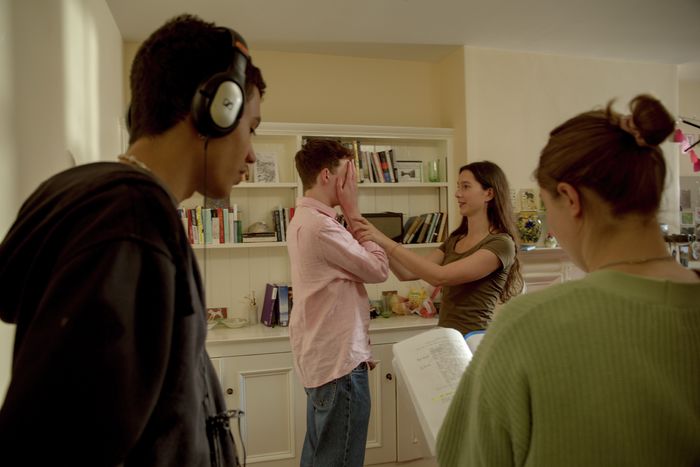With Gaslight, Shaira Berg tackles an uncomfortably present issue
Elspeth White interviews Shaira Berg the mind behind the play turned film Gaslight

Sitting down with Shaira Berg, writer, producer, and principal actor in short film Gaslight, she illuminated her visceral exploration of the impacts of sexual assault through body horror and dystopia. The premise of Gaslight is simple: undergraduate Scarlet is sexually assaulted and this experience manifests visually through a gaping, bloody wound. This wound grows and spreads in parallel with Scar’s PTSD. Despite this obvious fissure, the characters and the world around her let it fester, acknowledging its presence without ever attending to it.
“The horror of deliberate ignorance towards sexual assault is one also felt palpably in the present”
The metaphor is deliberately blunt. Set in a seemingly dystopian future, Berg and I are both quick to note that the horror of deliberate ignorance towards sexual assault is one also felt palpably in the present. It is unsurprising that survivors are turning to more gory images to make themselves heard. It is in this cry that Gaslight falls naturally into a canon of recent feminist body horror films, including Coralie Fargeat’s The Substance and Julia Ducournau’s Titane.
Visually, Gaslight aims to be no less daring than these bloody predecessors. Berg credits blood technician Maisie Johnson (repeating her role from the stage version of Gaslight in Pembroke New Cellars and in the Off-West End run) for her resourceful invention of the ‘blood bag’. Working with a running water bag filled with a concoction of shampoo and red food colouring attached to and controlled by Shaira’s body, Johnson creates a nauseatingly realistic wound that serves as a visual and thematic focal point for the film.
“Gaslight may be dealing with the body horror and the surreal, but it keeps in mind its roots in youth, nightlife, and the university experience”
Beyond the crimson, cinematographer Molin Liu creates a neon aesthetic (think Euphoria and Saltburn) that sears through the scenes with energy and edge. Gaslight may be dealing with the body horror and the surreal, but it keeps in mind its roots in youth, nightlife, and the university experience. We are reminded that the excessive neon spaces of clubs and parties are equally spaces of vulnerability, danger and pain. Berg mentions Molly Manning Walker’s How to Have Sex as a major inspiration for this visual and thematic paradox.
Like How to Have Sex, Gaslight is keen to balance bold motifs and metaphors with psychological realism and a nuanced portrayal of sexual trauma. This realism formed the basis of the original stage version, which stifled us in the aftermath of the assault through a series of chronological, dialogue-heavy scenes, with the wound’s visceral progression as a temporal anchor. The short film takes snapshots of these grounded moments and recycles them as a collage of flashbacks, anchored by a conversation with a ‘tutor figure’. Though dreamlike and non-chronological, these flashes remain devastatingly human, with Scarlet’s psychology and relationships taking centre-stage.
Gaslight handles its protagonist with empathy, keeping its naturalist acting style without indulging in its characters’ misery and trauma. Berg assures me that Scar exists beyond her PTSD as well as through and with it.
Indeed, Berg is more than qualified to create a psychologically believable and relatable character, having just received her PhD in Neuroscience. As part of this qualification, she created virtual reality scenes to work with OCD patients (working with BAFTA-winning company Ninja Theory), proving that the boundaries between art and science are not as solid as we may think. Gaslight seems like a natural continuation of this work, heightening the experience of PTSD through body horror to simulate for the viewer the frustration of obtaining justice, support and empathy after sexual assault.
In this way, Gaslight combines an intimate, relatable portrait of a survivor with a far-reaching call for institutional and societal change in the framing and handling of sexual violence. It is for this reason that the film’s setting is kept ambiguous. Despite its shooting in Cambridge (the Gonville and Caius MCR makes an appearance), Berg is keen that the message is heard beyond Cambridge. After all, Scarlet’s experiences will be familiar to people everywhere, and the accountability for these experiences should be placed on perpetrators and the cultures that fail survivors.
Behind this powerful message is a team composed of mostly students and funding from arts societies (the Shadwell Society to name just one), who truly believe in the project. Berg praises both the theatre and the film scenes in Cambridge for its ambition and sheer scale. Without them, she doesn’t imagine Gaslight would exist in the way that it now does.
“Berg praises both the theatre and the film scenes in Cambridge for its ambition and sheer scale”
Throughout our conversation, I do find myself in awe a little bit. Can you really do that as a student? The answer is yes. Tight budgeting, five-day shoots from 5am to 12am, creative vision and borderline delusion, and then you might find yourself aiming for South by Southwest film festival. You might even be pitching to production companies to get your film made into a feature-length, as the team behind Gaslight are currently in the process of doing.
And what then? The same as what I imagine Berg always wanted for Gaslight, and what Scarlet needed. To be heard, and for the survivors watching to hear. So that hearing will become the norm, and so that wounds can begin to heal.
 News / Eight Cambridge researchers awarded €17m in ERC research grants27 December 2025
News / Eight Cambridge researchers awarded €17m in ERC research grants27 December 2025 News / News in Brief: carols, card games, and canine calamities28 December 2025
News / News in Brief: carols, card games, and canine calamities28 December 2025 News / Caius mourns its tree-mendous loss23 December 2025
News / Caius mourns its tree-mendous loss23 December 2025 News / Clare Hall spent over £500k opposing busway 24 December 2025
News / Clare Hall spent over £500k opposing busway 24 December 2025 Interviews / Meet Juan Michel, Cambridge’s multilingual musician29 December 2025
Interviews / Meet Juan Michel, Cambridge’s multilingual musician29 December 2025









